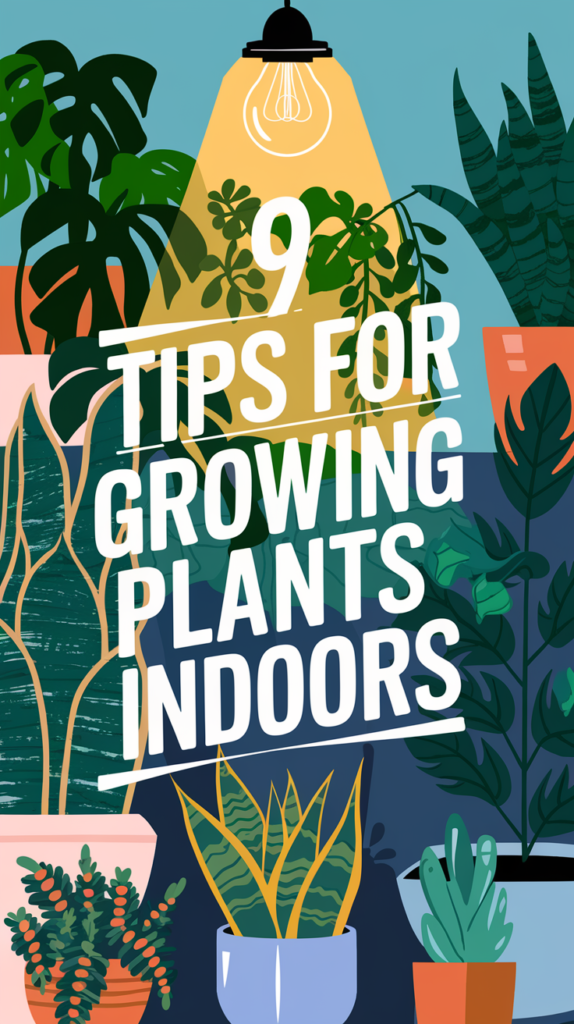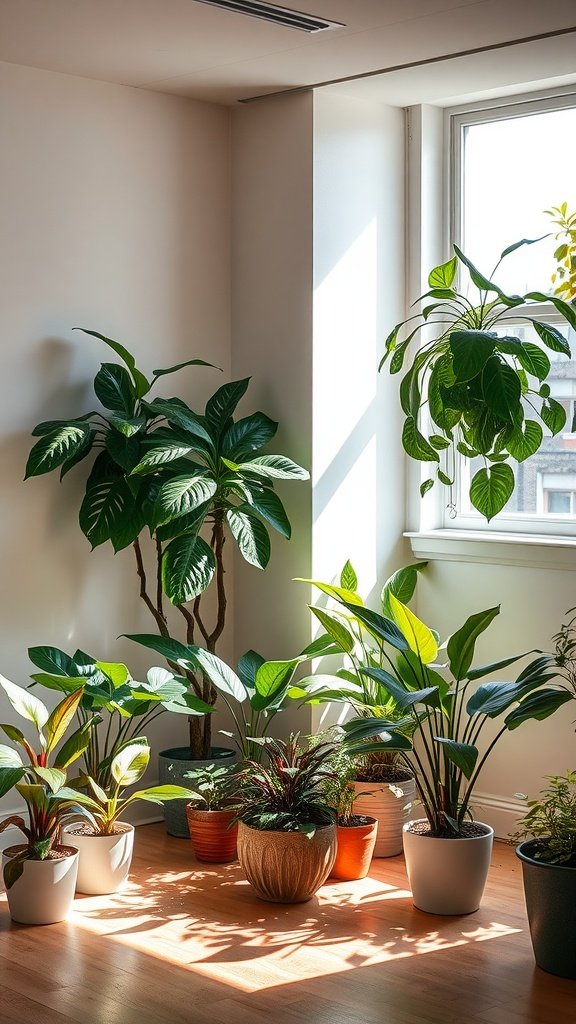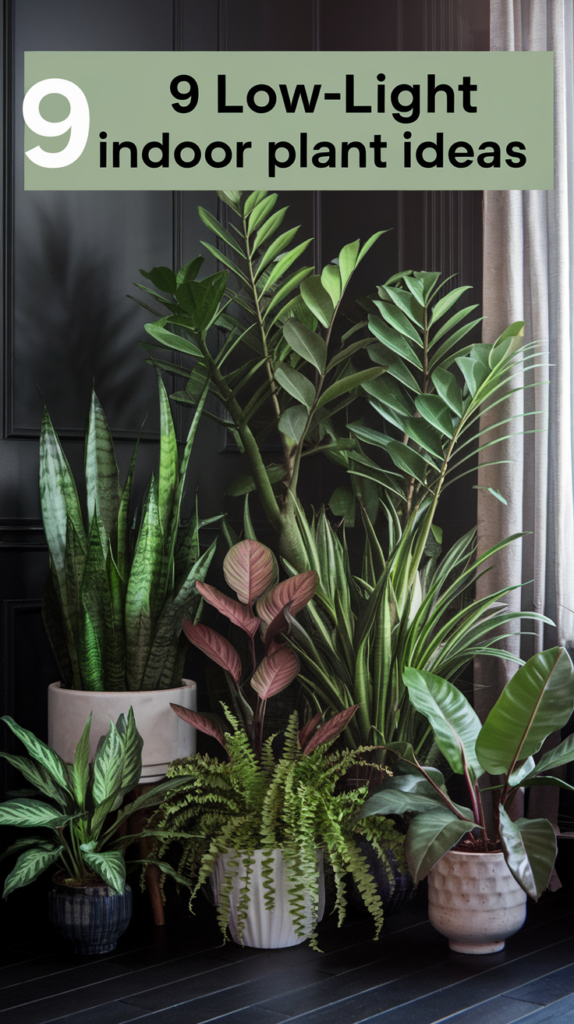9 Tips For Growing Plants Indoors For Year-Round Greenery
If you’re looking to add some greenery to your home all year round, growing plants indoors is a fun and rewarding hobby. With just a few tips, you can create a thriving indoor garden that brings life to any space.
Whether you’re a seasoned green thumb or just starting out, these nine tips will help you nurture your plants and keep your indoor jungle flourishing through every season.
Choosing the Right Indoor Plants
When it comes to indoor gardening, the right plants can make all the difference. In the image above, you can see a lovely display of various plants lined up on a windowsill. Each one adds a unique touch to the room, showcasing different shapes and colors that bring life indoors.
💥🎁 Christmas & Year-End Deals On Amazon !
Don't miss out on the best discounts and top-rated products available right now!
🛒 Shop Now and Save Big Today!*As an Amazon Associate, I earn from qualifying purchases.
Consider your space and lighting. Some plants thrive in bright light, while others prefer low-light conditions. The vibrant red plant in the image indicates a preference for moderate to bright light, while the green leaves of the others suggest they might be more forgiving in less ideal conditions.
Don’t forget to match the plants to your lifestyle. If you travel often or tend to forget watering, opt for hardy varieties like succulents or snake plants. The lush greenery in the image, such as the trailing vines, can also add a touch of elegance and may require more frequent care.
Finally, think about the aesthetic you want to achieve. Mixing textures and colors, as seen in the image, can create a vibrant atmosphere. Choose plants that complement each other, and you’ll have a stunning indoor garden that thrives all year long.
Optimizing Light Conditions
Light is one of the most important factors for growing plants indoors. In the image, you can see a variety of plants basking in the sunlight streaming through the window. This natural light not only brightens the space but also provides essential energy for the plants.
💥🎁 Christmas & Year-End Deals On Amazon !
Don't miss out on the best discounts and top-rated products available right now!
🛒 Shop Now and Save Big Today!*As an Amazon Associate, I earn from qualifying purchases.
When choosing where to place your indoor plants, consider how much light they need. Some plants thrive in bright, direct sunlight, while others prefer low light conditions. Observe how sunlight moves throughout your room during the day. This will help you identify the best spots for your greenery.
Using sheer curtains can help diffuse harsh sunlight, protecting delicate leaves from potential damage. If your plants are not getting enough light, you might consider using grow lights. These lights can mimic natural sunlight and can be especially useful during the shorter days of winter.
Remember to rotate your plants every couple of weeks. This ensures that all sides receive equal light, promoting even growth and healthier plants. With the right lighting, your indoor garden can flourish, bringing year-round greenery to your home.
Selecting Suitable Soil and Fertilizers
When it comes to growing plants indoors, choosing the right soil and fertilizers is a key step for healthy, thriving greenery. The image shows various types of soil and fertilizer bags lined up, ready for use. These components are essential for providing the necessary nutrients and support your plants need.
💥🎁 Christmas & Year-End Deals On Amazon !
Don't miss out on the best discounts and top-rated products available right now!
🛒 Shop Now and Save Big Today!*As an Amazon Associate, I earn from qualifying purchases.
Start by picking a potting soil that suits your indoor plants. Look for blends that have good drainage properties and are specifically formulated for container gardening. This helps prevent root rot and encourages healthy growth. The bags in the image illustrate different brands, each with unique formulas tailored for various plant types.
Next, consider adding fertilizers to boost your plants’ nutrient intake. Fertilizers come in several forms, including granules, liquids, and slow-release options. In the image, you can spot sorted fertilizers, which are handy for targeted feeding. Remember, different plants have diverse nutritional needs, so it’s wise to read the labels and choose accordingly.
Combining the right soil with suitable fertilizers is like giving your indoor plants their very own buffet! It’s all about balance, ensuring they get enough nutrients without overwhelming them. With these tips, you’ll be well on your way to creating a vibrant indoor garden all year long.
Temperature Considerations for Indoor Growth
When it comes to growing plants indoors, temperature plays a crucial role in their health. The image shows a thermometer placed near some vibrant indoor plants. It’s a great reminder of how important it is to monitor the temperature in your plant’s environment.
💥🎁 Christmas & Year-End Deals On Amazon !
Don't miss out on the best discounts and top-rated products available right now!
🛒 Shop Now and Save Big Today!*As an Amazon Associate, I earn from qualifying purchases.
Most indoor plants thrive at temperatures between 65°F and 75°F (18°C to 24°C) during the day. At night, they prefer a slight drop, ideally around 60°F to 70°F (15°C to 21°C). This variation mimics the natural temperature changes they would experience outside.
It’s also essential to keep your plants away from drafts and direct heat sources, like radiators or heaters. Sudden temperature changes can stress your plants, leading to wilting or stunted growth. If you notice your thermometer getting too low or too high, adjust your room’s heating or cooling accordingly.
Using a thermometer, like the one in the image, can help you keep track of these temperatures. Regular checks will ensure your indoor garden stays healthy year-round. With the right temperature, your plants will flourish, bringing a touch of nature into your home.
Pest Management Strategies
Keeping your indoor plants healthy is a rewarding experience, but it comes with its challenges, especially when it comes to pests. The image shows someone spraying a plant with a pest control solution, a vital step in protecting your greenery.
💥🎁 Christmas & Year-End Deals On Amazon !
Don't miss out on the best discounts and top-rated products available right now!
🛒 Shop Now and Save Big Today!*As an Amazon Associate, I earn from qualifying purchases.
First off, regularly inspect your plants. Look for any signs of pests, like tiny holes in leaves or webs. Catching these issues early can save you a lot of trouble later. If you spot something, consider using a gentle insecticidal soap or a natural remedy like neem oil. These options are effective and safer for your home environment.
Another handy tip is to keep your plants clean. Dust can attract pests, so give those leaves a good wipe down occasionally. A clean plant is not just visually appealing; it also helps prevent pests from setting up camp.
Lastly, encourage beneficial insects. Ladybugs and lacewings can help keep pest populations in check. You can attract them by planting certain flowers nearby or using a few tricks like placing a shallow dish of water with pebbles. It’s a simple way to foster a balanced ecosystem right in your home.
Pruning and Maintenance Techniques
Pruning is an essential part of indoor plant care that encourages healthy growth and keeps your plants looking their best. In the image, you see someone carefully using scissors to trim a houseplant. This simple act can make a big difference in your plant’s health.
💥🎁 Christmas & Year-End Deals On Amazon !
Don't miss out on the best discounts and top-rated products available right now!
🛒 Shop Now and Save Big Today!*As an Amazon Associate, I earn from qualifying purchases.
Start by removing any dead or yellowing leaves. This not only helps the plant but also improves its appearance. Make clean cuts, as jagged edges can attract pests or diseases.
Next, consider trimming back overly long stems. This encourages bushier growth and can prevent the plant from becoming leggy. Don’t be afraid to shape your plant as you like; just ensure each cut is intentional.
Regular maintenance also includes checking for pests. Look under the leaves and at the base of the plant for any signs of trouble. If you find any, a simple soap solution can often help.
Another important aspect is repotting. As plants grow, they may outgrow their pots. Make sure to choose a slightly larger pot and fresh soil to give your plant the space it needs to thrive.
Understanding Watering Needs
💥🎁 Christmas & Year-End Deals On Amazon !
Don't miss out on the best discounts and top-rated products available right now!
🛒 Shop Now and Save Big Today!*As an Amazon Associate, I earn from qualifying purchases.
Watering is one of the most important aspects of indoor gardening. The image shows a watering can pouring water into a potted plant, illustrating the basic process of keeping your indoor plants hydrated. Understanding how much and how often to water is key to ensuring your plants thrive.
Each plant has its own specific watering needs. Some prefer to dry out between waterings, while others like their soil to stay consistently moist. It’s helpful to research the particular needs of your plants. For example, succulents and cacti need less water compared to tropical plants.
Always check the soil moisture before watering. Stick your finger about an inch into the soil. If it feels dry, it’s time to water. If it’s still moist, wait a few days before checking again. This simple tip can prevent overwatering, which is a common mistake among indoor gardeners.
Using the right type of water can also make a difference. Tap water is usually fine, but some plants may benefit from distilled or rainwater. This is especially true for sensitive plants that can be affected by chemicals found in tap water.
Lastly, the frequency of watering can change with the seasons. During the warmer months, your plants may need more frequent watering due to increased evaporation and growth. In contrast, during the winter, they often require less. Keeping an eye on your plants and adjusting as needed will help keep them healthy all year long.
Maintaining Humidity Levels
💥🎁 Christmas & Year-End Deals On Amazon !
Don't miss out on the best discounts and top-rated products available right now!
🛒 Shop Now and Save Big Today!*As an Amazon Associate, I earn from qualifying purchases.
Humidity is a key player when it comes to growing plants indoors. Just like us, plants enjoy a comfortable environment. If the air is too dry, your plants might struggle to thrive. This image beautifully captures a humidifier working alongside lush green plants, creating an ideal setting for growth.
The humidifier releases a gentle mist into the air, which is essential for maintaining humidity levels. For indoor plants, a humidity level between 40% and 60% is usually ideal. This helps prevent issues like dry leaf tips and wilting. If you notice your plants looking droopy, it might be time to check the humidity in your space.
Investing in a good humidifier can make a noticeable difference. Place it close to your plants to ensure they get the moisture they need. You can also group plants together; this naturally increases humidity around them. As they release moisture through their leaves, they create a mini-ecosystem.
Keep an eye on your plants! If they seem to be struggling or you notice signs of dryness, don’t hesitate to adjust the humidity. Regularly misting the leaves can also help, especially during drier months or in heated rooms. Remember, your indoor garden deserves a comfortable home just like you do!
Repotting Your Plants for Growth
💥🎁 Christmas & Year-End Deals On Amazon !
Don't miss out on the best discounts and top-rated products available right now!
🛒 Shop Now and Save Big Today!*As an Amazon Associate, I earn from qualifying purchases.
Repotting is a key step to ensure your plants continue to thrive indoors. In the image, we see a young plant in a stylish pot, standing sturdy and ready for a new home. This setting highlights the importance of providing your plants with fresh soil and more space as they grow.
When a plant outgrows its pot, the roots can become cramped. This can lead to stunted growth. Repotting gives the roots room to expand, which is essential for the plant’s health. You can tell your plant needs repotting if roots are growing out of the drainage holes or if the soil dries out too quickly.
To repot, choose a pot that’s one size larger than the current one. Make sure it has drainage holes to prevent water from pooling. Gently remove the plant from its old pot, loosening the roots if they are tightly bound. Add fresh potting mix into the new pot, place the plant in, and fill around it with more soil. Water it well and watch it flourish!
Remember to repot during the growing season for the best results. This practice is simple but can lead to healthier and more vibrant plants throughout the year. So grab your soil and tools, and let’s get those plants repotted!














